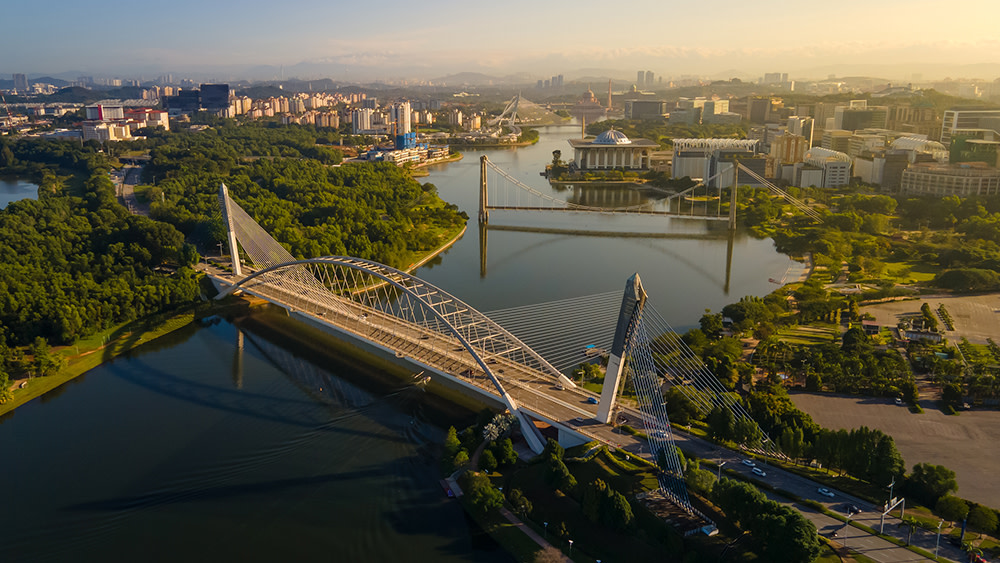Malaysia is considered a “mini Asia” on account of its multiethnic population, the majority being Malays, Chinese, and Indian. The country is ranked #12 in UNESCO’s Top 20 countries for international study destinations. Here, international students, particularly those who attend Heriot-Watt University Malaysia, are sure to find community and reminders of home in Putrajaya and nearby Kuala Lumpur.
As a fairly new city that is home to many of the country’s government offices, Putrajaya, or officially the Federal Territory of Putrajaya, serves as the federal administrative center of the country. Malaysia’s former Prime Minister, Tun Dr Mahathir Mohammad, planned the city to alleviate some of Kuala Lumpur’s congestion and named it after the country’s first Prime Minister, Tunku Abdul Rahman Putra. Putrajaya is now home to the current Prime Minister, Datuk Seri Anwar Ibrahim. It is also considered one of the safest cities in the country, making it an ideal place for international students to explore.
Life in Putrajaya
While the manmade city of Putrajaya is relatively new, there are many reasons why it’s a great place for international students to live, such as its affordability in comparison to other countries, safe surroundings, dynamic architecture — for example, the pink dome of the Putra Mosque — impressive bridges, and balmy weather year-round (averaging between 23°C to 33°C).
Boasting one of the first and largest manmade freshwater wetlands, Putrajaya Wetlands Park, and recognized as an Ecohydrology Demonstration Site by UNESCO, the city values nature and offers a variety of places to enjoy the great outdoors, including the Putrajaya Botanical Garden with its Moroccan Pavillion Islamic Garden, the China-Malaysia Friendship Garden, and the Putrajaya Lake, among others.
Nearby Kuala Lumpur’s Cultural Districts
As the nation’s capital, Kuala Lumpur is home to people from around the world and boasts a range of cultural neighborhoods. The city is located just 20 miles from Putrajaya, making it an easy trip for international students who are feeling homesick and seeking familiar foods, scents, and sounds. The KLIA Transit provides quick transportation with 20-minute train rides (about $3 USD each way) between the two cities; Heriot-Watt University Malaysia also has a guide to regional transit options.
Indian Areas
As the second-largest ethnic minority (next to Chinese), the Indian population in Kuala Lumpur is strong, and there are several areas in the city where international students will find a concentrated Indian community.
Brickfields
Though Brickfields is home to generations of Indian families and is the oldest Indian neighborhood in the city, it was only recently named “Little India.” The neighborhood’s Torana Gate was inaugurated in 2015 and stands as a symbol of Indian and Malaysian friendship. Beyond Torana Gate, international students will experience the culture of their home country in the familiar smell of spices, vibrant colors of sari and jewelry shops, and the sounds of music from their homeland.
Among the inexpensive mamak stalls (fusion of Malay and Tamil dishes), there are a variety of Indian restaurants serving authentic fare. Some popular spots include MTR (South Indian vegetarian chain), Brickfields Pisang Goreng (fried banana fritters), and Sithique Nasi Kandar Pulau Pinang (self-serve Halal food), among many others. For international students wanting to worship, the Sri Kandaswamy Kovil Temple or the Tamil Methodist Church offer places to pray. Additionally, the Indian Cultural Centre hosts many events throughout the year and provides resources to get involved with the local community.
Jalan Masjid India
Considered the original “Little India,” Jalan Masjid India is a pedestrian-only street that was named for the Jamek Mosque (Masjid Jamek). The area may feel more like a Middle Eastern bazaar, with crowds of people shopping the variety of vendors selling all types of Indian goods and food. The Jalan Masjid India Night Market on Saturday nights can be even busier, but provides a great time for international students to feel at home.
Chinese Areas
Settling in Kuala Lumpur as tin miners in the late 18th century, Cantonese and Hakka immigrants forged the way for the flourishing Chinese community that exists in the city today. Chinatown runs along Jalan Petaling, or Petaling Street, which is one of the most photographed streets in the city with its variety of wooden carts, authentic food stalls, and crowds shopping for a bargain under the shade of a green awning.
As the official cultural and tourism institution stationed by the Chinese government in Malaysia, the Kuala Lumpur Chinese Cultural Centre provides many resources for international students to forge links with their community, as well as hosts many cultural events throughout the year. International students who would like to worship can visit the Taoist Guan Di Temple and the Thean Hou Temple.
Latinx Areas
There may not be a specific neighborhood devoted to Latinx culture, but there are a variety of restaurants catering to Central American and Spanish flavors throughout the city. Tacos are a favorite Mexican food among locals, and popular spots for the college crowd are Thyme Out, Curbside Cantina, Sala (vegan), and Chachi Mexican Street Food (try the Tajin shrimp and pineapple tacos). Fresca Mexican is a great option for tastes beyond the taco, and the restaurant makes everything in house, including its guacamole and corn tortillas.
There are several options for international students to worship, if they desire, including the Church of Our Lady of Fatima and the Catholic Church of the Holy Rosary.
African Areas
Though there are more people from the African continent moving to Malaysia each year, the population is still relatively small in comparison to other minority groups. It is still possible, however, to find the familiar flavors of home in several authentic African restaurants. Joloko is a hip spot that serves Afro-Caribbean BBQ, including items like Jamaican jerk chicken, jollof rice, and grilled okra. Owned by a Nigerian-Malaysian family, African Kitchen offers a range of traditional dishes, such as efo riro, agege soft bread, ebesi, yam fufu, and more. Out of Africa Restaurant’s poolside location is a great spot to taste authentic dishes like biltong, Braaied Boerewors, Lamb Bobotie, and others.
Feel at Home Without Leaving Campus
Heriot-Watt University Malaysia
As the first ‘green campus’ in the country, Heriot-Watt University Malaysia offers international students the opportunity to study in cutting-edge educational and research facilities that adhere to strict environmental guidelines. The £35 million campus was built specifically with students and sustainability in mind, and officially opened its doors in 2014. Its 4.8-acre campus overlooks Putrajaya Lake, and is close to the Putrajaya Marina, with a variety of sporting and entertainment options for students.
As a global university, Heriot-Watt University Malaysia provides on-campus support for international students through its Global Students Office, which helps with academics, housing, finances, visas, and more. The university also offers intercampus transfers for studying abroad at other Heriot-Watt University campuses in the UK and Dubai. International students can meet new people and participate in school activities by joining one of the available clubs and societies, such as the Chinese Cultural Society. There are many sports and recreational facilities in Putrajaya, which offer special rates and discounts to students.
The international diversity of the university ... I get to meet people from all walks of life as the university has a great mobility program, allowing students from other countries to come here, and vice versa. This gives me great exposure on the global context in terms of culture and diversity.” – Penny, psychology and management, Heriot-Watt University Malaysia
Finding a Home Away from Home
Putrajaya provides a safe and rich environment for international students to study while still being close enough to the cultural reminders of home in nearby Kuala Lumpur.
Shorelight can help find your best-fit university for your study abroad plans >

